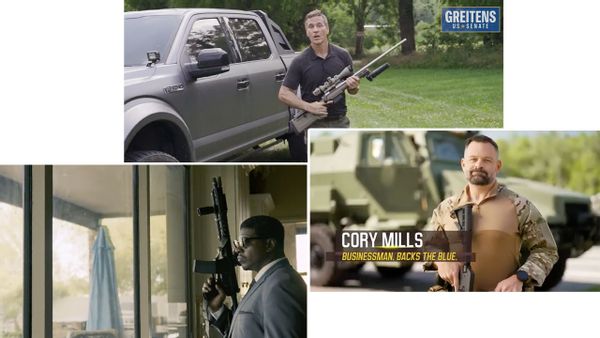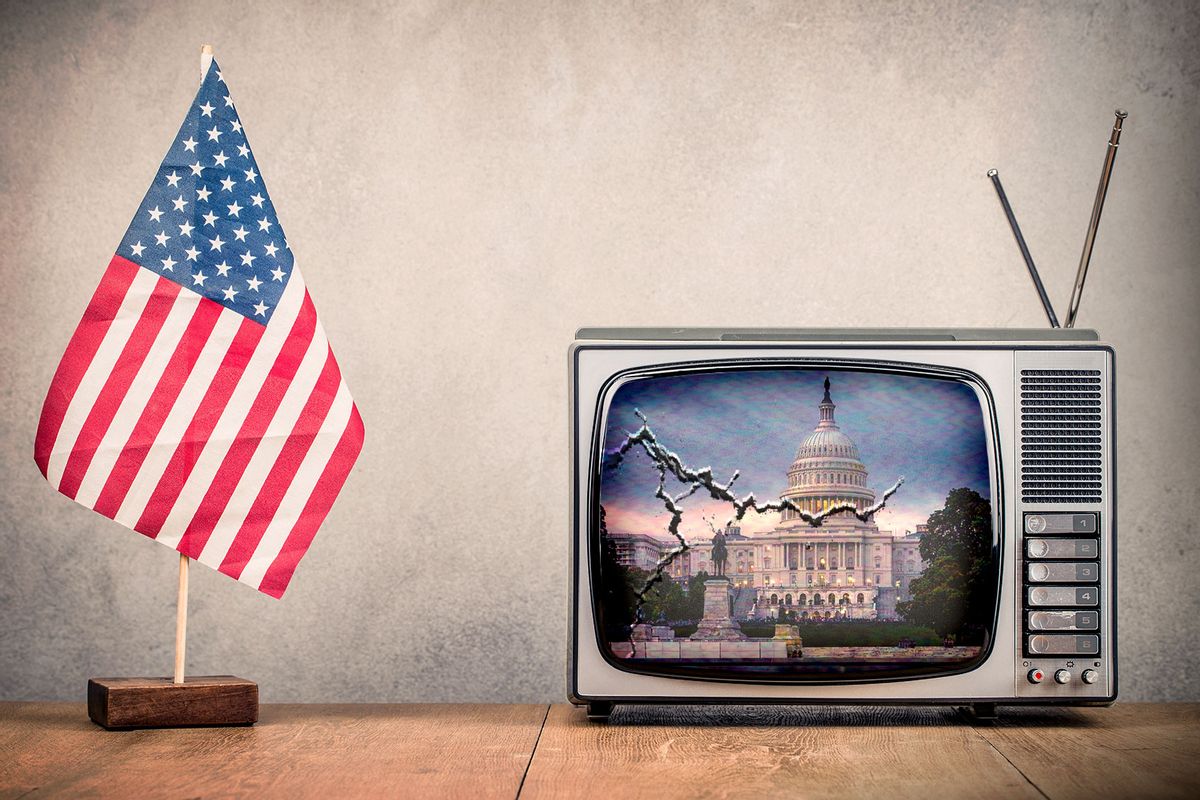Control of the House and Senate is in play in this year's midterm elections, with many races too close to call. Stakes seem higher because, according to FiveThirtyEight, 60 percent of American voters will have an election denier on the ballot this fall. Campaign ads, in many cases, shape these races and may determine the outcomes: It's estimated that $9 billion will go into the production and distribution of the 2022 midterm ads.
Gaining a bird's-eye view of all this political advertising can be difficult. Only a small proportion of campaign ads are posted on YouTube, and the sheer number of races makes it prohibitive to follow each candidate's website and social media. The company Ad Impact, which records and quickly uploads all ads screened on television and streaming services, lent me access to their database, and I was also able to interview staff at advertising firms like Middle Seat, Authentic and Kantar. This article is meant to provide a way of thinking about the ads — about their generic traits and stylistic shifts, as well as a grounding in the clips that particularly stand out.
My research focuses on audiovisual aesthetics in brief media, like music video, TikTok and post-classical film sequences. (You can find links to my books in the author blurb below.) I think of political ads as a sibling to those things. My ways of looking at ads are shaped by these other genres. Over the years, music and image have become more closely intertwined — blockbuster cinema, commercials and music videos, among others, have played a role. Many politically-based clips are audio-visually intensified.
The 2022 campaign ads participate in several genres, but almost all fall into two larger bins. The first bin includes clips intended to induce anxiety and fear. Republicans deploy this aesthetic more than Democrats, and they do so to message about immigration, crime and taxes. Neuroscientists have found that a proportion of the population is more respectful of hierarchy and more fearful of contagion, and that this population tends to correlate with conservative Republicans.
These ads' audiovisual aesthetics seek to persuade viewers through desaturated colors, especially wan blues and grays. Often the image has been textured to reduce information, and perhaps to resemble a television screen. These techniques, along with depictions of Democrats as dehumanized, grimacing cutouts, create greater distance between viewers and candidates. Fractured fonts suggest that dissolution has infiltrated everywhere. The text is usually alarmist — e.g., "chaos in the streets."
The second main bin is the biopic. The candidate, or the person speaking for her, might note that she was born and raised in the voter's district. Her parents may have struggled making ends meet managing a hardware store while she waited tables at a local diner. She, a family member or friend may have experienced disability, serious illness or a death in the family. The candidate has known hardship and may directly claim that she understands you, and that you can count on her to create a better future. These biopics, as well as the fear-inducing ones, often end with a turn to more hopeful imagery: an open window or a door, factory lights turning on, or the candidate and constituent together outside in the sun.
 Campaign ads for Eric Greitens (T), Jerone Davison (L) and Cory Mills (R) (Salon/Twitter/@EricGreitens/@Jerone4Congress/YouTube/Cory Mills)
Campaign ads for Eric Greitens (T), Jerone Davison (L) and Cory Mills (R) (Salon/Twitter/@EricGreitens/@Jerone4Congress/YouTube/Cory Mills)
Overall, the Republican ads this cycle seem blunter and more forceful than Democratic ads. They often feature white men, occasionally women, and only rarely a person of color. The males are often assertive and beefed up, wielding guns and stand by their trucks or tractors. Hundreds of ads during this 2022 cycle featured guns. The points made are staccato and simple — pro-gun, pro-wall, pro-life, anti-establishment media, anti-inflation, anti-socialism. They target an "other" (immigrants, the "Squad," alleged supporters of "critical race theory"). Images of civil unrest are almost always drawn from the Black Lives Matter protests of 2020 rather than the Capitol attack of Jan. 6, 2021, with no mention of the latter.
Republican ads often star assertive and beefed-up white men, wielding guns and standing by their trucks or tractors. Hundreds of ads this year have featured guns.
By contrast, Democrats' commercials may probe a single issue, like abortion or health care costs. Democratic claims seem easier to make nationally. Here's an ad for Joe Biden's Inflation Reduction Act.
Exactly what role is played by auxiliary media content surrounding the ads remains an unstudied subject: Think of Pennsylvania GOP candidate Dr. Mehmet Oz's gaffe with "crudités," the revelation of Georgia candidate Herschel Walker's domestic violence issues or his uncertainty about how many biological children he has. Or Arizona Republican candidate Blake Masters, who dressed in faux-Native American face paint as a college student, while rapping that no one needs to care about his cultural appropriations.
Want a daily wrap-up of all the news and commentary Salon has to offer? Subscribe to our morning newsletter, Crash Course.
Campaign ads also make use of popular media like TikTok and classic Hollywood films to create a viral buzz that encourages campaign contributions nationally. (Pennsylvania Democrat John Fetterman has relentlessly tried to capitalize on Dr. Oz's gaffe). Linda Paulson, a Republican state Senate candidate in Utah, is circulating a TikTok rap number. With similar aims, Florida Gov. Ron DeSantis produced a spoof on "Top Gun," while defeated Arizona GOP House candidate Jerone Davison's ad played on the history of "blaxploitation" films and D.W. Griffith's notorious "Birth of a Nation." An ad attacking Nevada Republican Senate candidate Adam Laxalt — whose grandfather was a famous political figure in the state — plays off the HBO series "Succession."
A GOP state Senate candidate in Utah made a TikTok rap video. Ron DeSantis produced a "Top Gun" spoof, while defeated Arizona GOP candidate Jerone Davison played on "blaxploitation" films.
Several industry practitioners have noted that the camera doesn't love all candidates equally; rapport with the camera can't be faked. In this ad for Alabama GOP Senate nominee Katie Britt, her clothing, along with the foliage and landscape surrounding her are all a verdant green. She then mentions the wire grass of Alabama, to connect text and visuals. This, along with the photo of children seated side by side on a bench, seem to prepare for the image of Britt sitting in a church pew in church with her Bible (certainly a crucial set of signifiers in the South). She gestures effectively, underscoring several words in rhythmic fashion while warmly addressing the camera. Her Facebook page is similarly inviting.
Moving to the other side of the aisle, the images in this ad for Wisconsin Democratic Senate nominee Mandela Barnes are also lovely: the welcoming door, the calf, the young girl's face. There's little explicit political content in this ad, but viewers are clearly meant to believe that Barnes is a gentle, caring person.
In this cycle, many Republicans have presented a kind of toughness and even overt aggression. This includes prominent candidates such as Ron DeSantis, Brian Kemp, Kari Lake and Blake Masters, often taking a strong stance against gun restrictions. The Black Democrats, such as Georgia gubernatorial candidate Stacey Abrams, Kentucky U.S. Senate candidate Charles Booker and Sen. Raphael Warnock of Georgia, like Barnes, present themselves as calm, warm, centered and caring. Does this tell us something larger about America as a nation?
 Campaign ads by One Nation (L-R) and NRCC (T) (Salon/One Nation/NRCC/Lisa Scheller)
Campaign ads by One Nation (L-R) and NRCC (T) (Salon/One Nation/NRCC/Lisa Scheller)
Many 2022 campaign ads might be described as thin. This ad attacking Warnock, the Democratic incumbent in Georgia, leaves out important context. As is common with major across-the-aisle legislation, the Inflation Reduction Act allocates funds for representatives to distribute to constituents within individual locales. The viewer's district probably got some money too. Warnock is paired with a Nevada ski slope and a Florida resort, while Ohio Democratic Senate candidate Tim Ryan is linked to a Connecticut poet and a French opera performed in Washington, D.C. Might the latter have been funded by the National Endowment of the Arts, which takes up a minuscule amount of the government's budget? Do these ads reflect racial biases? Why wasn't Warnock paired with opera? This ad was a template created by the One Nation super PAC to be screened across six states for six different candidates.
Many Republican ads are clearly generated at the national level and adopt a cookie-cutter approach: Marching IRS agents who resemble Agent Smith of "The Matrix," a tattooed immigrant, a gas pump's rising digital numbers.
Here's another: "Inflation is killing us, and it's Joe Biden's fault." Anyone who's carefully following the news would know that we're still in a pandemic and there are still global supply-chain problems, as well as a war in Ukraine and worsening global climate change. Most people with some education in economics know that controlling inflation without causing recession is difficult. These economic shifts manifest slowly and can't be quickly reset.
Ads today are sometimes required to back up their claims; evidence often appears on screen, in tiny print. Still, much can be taken out of context. At Middle Seat, which represents John Fetterman, a staff person noted that Oz's team has accused Fetterman of being weak on crime, claiming that he was the only committee member to vote to release a murderer. But the ad fails to mention that the man in question was 70 years old, and had been incarcerated for many years. The risk that he would commit another violent crime was almost nonexistent. Fetterman's rejoinder may be successful because it employs humor and is audiovisually intensified. The soundtrack alludes to Nine Inch Nails and other industrial bands. There's a beguiling array of post-production devices, including polarization, grain, mats, blurs and wipes.
Viewers may assume the clips they watch are shaped for their local candidates, but many Republican ads appear to have been generated at the national level and adopt a cookie-cutter approach: Marching IRS agents who resemble Agent Smith of "The Matrix," a tattooed immigrant, the gas pump's rising digital numbers shot at an angle, the cutouts of threatening Democrats, clinking glasses of alcohol.
Negative ads can be highly effective, and almost certainly the right deploys them more, although since Labor Day there have been several more from Democrats. Such ads galvanize the base, but can also create blowback, angering voters who may wish a plague on both your houses and choose not to show up. Negative ads, in that sense, can become a form of voter suppression. Many ads that disparage candidates leave unclear exactly who is angry, perhaps to protect the message-senders (since entities like national Republican campaign groups or super PACs are literally faceless).
 Campaign ads for Jerone Davison (T), Kari Lake (L) and Blake Masters (R) (Salon/Twitter/@Jerone4Congress/YouTube/Blake Masters for Senate/Facebook/TheKariLake)
Campaign ads for Jerone Davison (T), Kari Lake (L) and Blake Masters (R) (Salon/Twitter/@Jerone4Congress/YouTube/Blake Masters for Senate/Facebook/TheKariLake)
A few ads could be said to mirror a paranoid strain in America. These ads for far-right Arizona candidates Kari Lake (governor) and Blake Masters (U.S. Senate) feel dystopian, in part because of their audiovisual relations. In both, the music seems sour; it floats, while not quite attaching to image or text. This ad for losing House candidate Jerone Davison, which appropriates Hollywood cinema convention, keeps feelings and structure about race in place, but inverts the actors, rendering its relations hard to fathom.
Ads for Democrats often seem to come from behind, but they can be witty. Here's a Lincoln Project ad that's meant as a rejoinder to Kari Lake.
Let's read some ads more closely.
An ad for New York Democrat Pat Ryan starts with a conservative feel: patriotic music, the American flag, images of the military. It's a new kind of claim for the pro-choice position — and he won.
Many candidates showcase their backgrounds in the military, especially Republicans. This ad for New York Democrat Pat Ryan (who won a recent special election for a House seat) starts with a conservative feel: patriotic music, the American flag, and images of the military. Then Ryan turns sharply toward us as if he's breaking the fourth wall — we're now out of the box. Next, he strides toward us through a hospital lobby. He's not a doctor, but his comportment and the setting give him authority. He turns to us again. The music pivots to something faster, more rhythmic and upbeat. Ryan's ad, intended to reach undecided voters, draws on the campaign-ad convention of bifurcating a clip into two parts, with more positive material in the second half. Ryan's play with genres enables him to make a new kind of claim for the pro-choice position.
Here are two ads critical of Arizona GOP candidate Blake Masters. I believe I've seen Masters' original footage and it seems likely the makers reddened his face in post-production to make him look more foreboding. Masters seems outside the rhythm and flow of the music, even when he reaches out to us in a gesture of supplication. The music seems to seek something, pushing past him, finally finding itself among women whom we might guess possess greater wisdom. When Jackson Hyland-Lipski, the art director for Middle Seat, watched the clip with me, he said, "Yes, it's a lovely ad, but it's not going to change the minds of many voters. There isn't much content."
Here's Hyland-Lipski's pro-choice ad for Beto O'Rourke, the Democrat running for governor in Texas. He designed the image, including the stylization of the fonts and the soundtrack. Neuroscience research has demonstrated that we don't experience the world directly, but rather through expectations, known as Bayesian inferences. The brain's attempt at multisensory integration is but a calculation. I actually misheard a crucial moment in the clip, both in content and in meaning (the moment the voiceover says, "It's here."). Only by listening closely a second time could I tell what was unfolding. Here's a reason to engage with neuroscience and audiovisual aesthetics.
Ads can make a difference. Pat Ryan's pro-choice ad likely helped him win an upstate New York district where Republicans thought they had the advantage, and now everyone is responding in kind. Ads often respond to cultural moments, as with the wave of pro-choice ads that followed the Supreme Court's Dobbs decision. FiveThirtyEight recently reported that out of 552 total Republican nominees running for office, 201 denied the legitimacy of the 2020 election. Recently, some ads have appeared targeting individual candidates directly on this issue. Rejoinders to these haven't appeared yet.
Ben Taber at Ad Impact told me he expects ads to become increasingly strident in the final weeks before the midterm elections. In the final stretch of the last presidential election, the Trump campaign screened clips of intruders breaking into homes while 911 calls went unanswered. One Republican theme emerging over the past week has been the claim that Biden's Inflation Reduction Act caused our current inflation, and that billions in new taxes will need to be paid out by the working and middle class, some of it going to incarcerated criminals like the Unabomber.
It's important for us to watch attentively and think critically about political advertising. There are ways to create the sharing of more accurate and nuanced information. DeSantis' "Top Gun" ad, for example, ends with a QR code. If those were ubiquitous, viewers could access more information on a topic or candidate.
More "meta ads," like those produced by the Lincoln Project, might also be useful. Such ads might explore questions like the government funding of education, particularly about history. Do we want to place our hopes in a progressive government? Do we believe that corporations are benign? How much responsibility must they have to shareholders, as opposed to workers and consumers? How much has the crime rate actually increased (or not) compared to the previous several decades? How much has immigration changed and what does this mean for people living in the U.S.? Such ads might shape not just a specific election, but also how viewers perceive and understand democracy. We could all commit to better ways of understanding, responding to and talking about campaign ads.



Shares